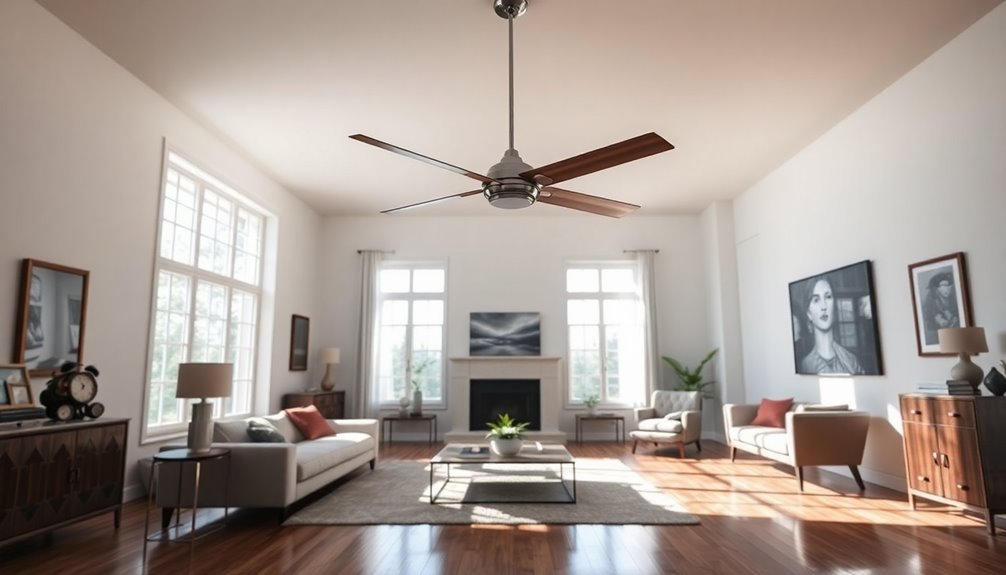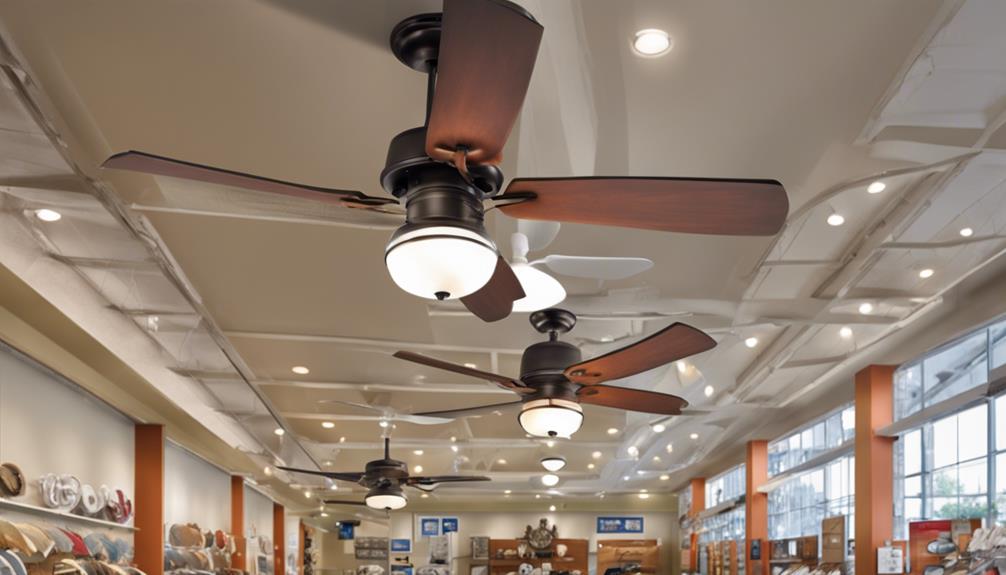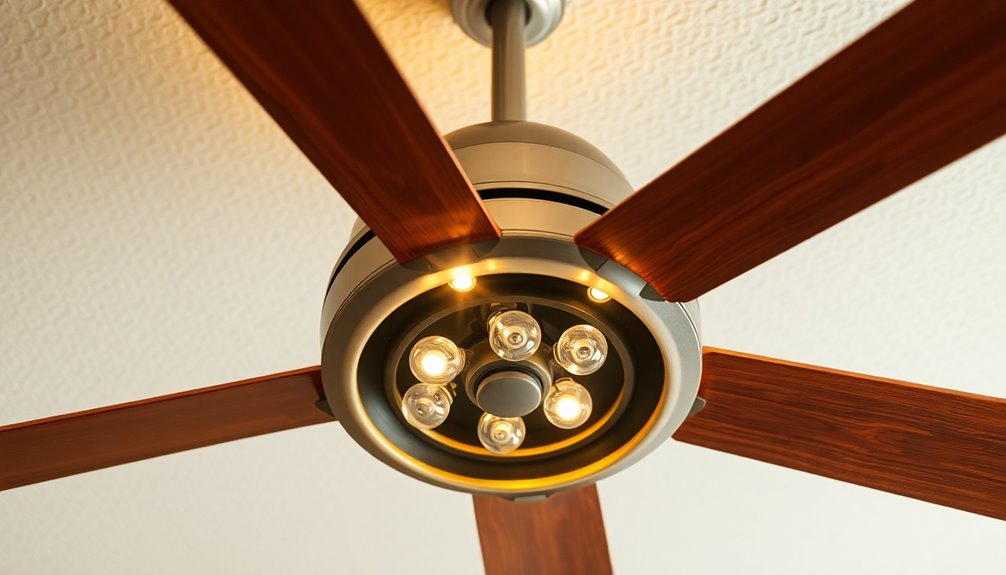In the summer, your ceiling fan should spin counterclockwise. This direction creates a cool downdraft that pushes air down into the room. You'll feel a nice breeze that can make you feel about 4 degrees cooler, letting you raise your thermostat without discomfort. Running your fan this way can also help cut energy costs by reducing the load on your air conditioning. Remember to check the blade angle for ideal airflow too. If you're interested in tips for maximizing your fan's efficiency and comfort, there's more to explore on maintaining and adjusting your ceiling fan settings.
Key Takeaways
- In summer, ceiling fans should rotate counterclockwise to create a downdraft that pushes cool air downward.
- This counterclockwise motion enhances the wind chill effect, making the room feel cooler by up to 4 degrees.
- Running a ceiling fan saves energy by allowing higher thermostat settings, potentially reducing cooling costs by 30%.
- Fans should be set to counterclockwise for optimal airflow, with a recommended blade angle of 12 to 16 degrees.
- Always ensure fans are turned off when rooms are unoccupied to conserve energy and maintain efficiency.
Ceiling Fan Direction Overview

Ceiling fans are often overlooked, but they play an essential role in keeping your home comfortable during the hot summer months. To maximize their effectiveness, it's vital to understand the right ceiling fan direction.
In summer, you should always turn your fan counterclockwise. This motion creates a downdraft that pushes cool air downward, giving you that invigorating breeze you crave.
When the ceiling fan rotates counterclockwise, it enhances the wind chill effect, making you feel cooler even when the actual temperature isn't drastically lower. This simple adjustment allows you to raise your thermostat by about 4 degrees without sacrificing comfort.
As a result, you can reduce your air conditioning usage considerably, leading to impressive energy savings—up to 30% during those sweltering summer days. Additionally, using a ceiling fan in conjunction with your air conditioning can improve the overall efficiency of your system, making your home more comfortable while saving energy.
To check if your fan is set correctly, stand directly under it. If the air is blowing down on you, it's working as it should.
Benefits of Counterclockwise Motion

When your ceiling fan spins counterclockwise in the summer, you create an invigorating wind chill effect that makes you feel cooler instantly.
This motion not only enhances air circulation but also helps you save on energy costs by allowing you to raise your thermostat setting. Regular maintenance of your ceiling fan can prevent issues like clicking noise which may indicate mechanical failure.
Embracing this simple adjustment can lead to a more comfortable home and reduced energy bills.
Wind Chill Effect
Using a ceiling fan in counterclockwise motion during summer creates a revitalizing wind chill effect that enhances your comfort. This motion pushes cool air down, making you feel noticeably cooler without actually changing the room temperature. You can enjoy the benefits of this wind chill effect, allowing you to raise your thermostat setting by about 4 degrees Fahrenheit while still staying comfortable.
Here's a quick overview of how counterclockwise motion influences your cooling experience:
| Aspect | Effect | Benefit |
|---|---|---|
| Direction | Counterclockwise | Generates a downdraft of cool air |
| Cooling Efficiency | Enhanced due to angled blades | Maximizes airflow |
| Comfort | Wind chill effect | Feels cooler without lowering temp |
| Air Conditioning Costs | Reduces overall use by up to 30% | Saves money on energy bills |
Energy Cost Savings
Experience significant energy cost savings by running your ceiling fan counterclockwise during the summer. This simple adjustment can lead to a more comfortable environment while drastically cutting your cooling costs.
Here's how making the right ceiling fan direction can benefit you:
- Lower energy bills: You can raise your thermostat by about 4 degrees without losing comfort, translating to significant energy savings.
- Reduced air conditioner load: By improving airflow, you lessen the workload on your air conditioner, which can help it last longer. Additionally, using ceiling fans in conjunction with geothermal heat pumps can create a highly efficient cooling system.
- Efficient cooling: Ceiling fans consume only about 50 watts compared to the 3,500 watts used by air conditioning units.
When your fan spins counterclockwise, it creates a downdraft that pushes cool air down, enhancing your comfort. This can reduce your energy costs by up to 30% during the summer months. Additionally, using ceiling fans in conjunction with energy-efficient heat pumps can further optimize your home's cooling system and provide increased savings.
Pairing your ceiling fan with ENERGY STAR AC units can yield an additional 8% energy savings.
Enhanced Air Circulation
Ceiling fans' counterclockwise motion greatly boosts air circulation, making your space feel cooler and more comfortable during the summer heat.
When your ceiling fan spins in the counterclockwise direction, it creates a downdraft that pushes cool air down, generating a rejuvenating cool breeze. This airflow not only enhances comfort but can also reduce the perceived temperature by up to 4 degrees.
By adjusting the ceiling fan direction to counterclockwise, you can set your thermostat higher without sacrificing comfort, leading to significant energy savings.
In fact, a well-functioning ceiling fan can improve cooling efficiency and reduce energy costs by up to 30% when used alongside an air conditioning system.
To maximize the benefits, verify your fan blades have a minimum angle of 12 degrees, which helps optimize airflow.
Regularly checking that your ceiling fan is set to counterclockwise during the summer is vital for effective air circulation and maintaining a consistent room temperature.
With these adjustments, you'll enjoy a more comfortable environment while also saving on your energy bills.
Adjusting Ceiling Fan Settings

Adjusting your ceiling fan settings for summer is crucial for maximizing comfort and energy efficiency. To guarantee you're getting the most from your ceiling fan, keep these tips in mind:
- Always check the ceiling fan direction; it should spin counterclockwise.
- Running your fan at high speed can markedly cut energy costs.
- Regular adjustments to your fan settings help maintain ideal airflow.
During the warmer months, your ceiling fan should spin counterclockwise to create a downdraft, pushing cool air downwards. This motion generates a wind chill effect, making you feel cooler and allowing you to raise your thermostat by about 4 degrees without losing comfort. Additionally, using fans in conjunction with commercial grade heat pumps can lead to even greater energy efficiency. Energy-efficient systems can significantly reduce your overall energy consumption.
To confirm your fan's direction, stand directly beneath it and feel for airflow directed downwards.
If your fan isn't set correctly, it's time to change your ceiling fan settings. Regularly adjusting the fan direction helps improve cooling and heating efficiency while enhancing air circulation. Additionally, using ceiling fans in conjunction with heat pump systems can further increase overall energy efficiency in your home.
Blade Angles for Optimal Cooling

To enhance the cooling effect of your ceiling fan, pay close attention to the blade angles. The minimum blade angle recommended for ideal cooling is 12 degrees. This angle maximizes airflow without causing disruption to loose objects in the room.
If you set the blade angles above 16 degrees, you may create excessive turbulence, which can disturb items nearby and reduce the fan's efficiency.
For effective air circulation in larger rooms exceeding 500 square feet, consider using multiple fans. A single fan mightn't provide adequate airflow to cool the entire space. By adjusting the blade angles properly, you can considerably improve cooling efficiency, making it essential to verify the blades are positioned correctly.
Additionally, regular maintenance is crucial. Checking the blade angles consistently helps sustain ideal cooling functionality throughout the summer months.
Seasonal Maintenance Tips

To keep your ceiling fan working efficiently this summer, you'll want to adjust its direction and speed appropriately. Regularly cleaning the blades and checking that it's installed at the right height can make a significant difference in cooling performance. Additionally, using best home security systems can enhance your overall comfort by ensuring a safe environment while you enjoy the cool breeze. Energy Star certified fans can also offer enhanced efficiency, allowing you to save on energy bills during the warmer months. Air purifier maintenance is also essential for maintaining a healthy indoor environment during the summer months.
Let's explore how these simple maintenance tips can enhance your comfort and save energy.
Adjusting Fan Direction
Switching your ceiling fan's direction for the summer months can greatly enhance your comfort and reduce energy costs. By adjusting the fan to rotate counterclockwise, you'll create a downdraft that pushes cool air downwards, providing a revitalizing wind chill effect.
This simple change can help you raise your thermostat settings by about 4 degrees without sacrificing comfort, potentially cutting energy costs by up to 30%.
Here are a few tips to guarantee you're making the most of your ceiling fan direction:
- Always turn off the fan before changing its direction to avoid damage.
- Confirm fan blades are at a minimum angle of 12 degrees for peak airflow.
- Regularly check the fan direction during seasonal changes, like Daylight Savings Time.
To change the direction, simply locate the switch on the fan's motor. If your fan turns clockwise, flip the switch so it rotates counterclockwise.
This adjustment is essential for maximizing cooling efficiency during warmer months, as many best air flow ceiling fans are designed specifically for this purpose. Embrace the cool air and enjoy a more comfortable summer!
Optimal Fan Speed
Adjusting your ceiling fan's direction is just the first step in maximizing its cooling benefits.
To truly enhance your cooling performance during summer, you should also focus on setting the ideal fan speed. Running your ceiling fan at high speed creates a powerful downdraft that effectively pushes cool air downward, making the room feel considerably cooler.
By maintaining this high speed, you can comfortably raise your thermostat setting by about 4 degrees without sacrificing comfort. This adjustment not only keeps you cool but also reduces air conditioning energy costs by up to 30%. It's a simple way to save money while staying comfortable.
Regularly checking and adjusting your fan speed is key to achieving consistent air circulation throughout the room. If certain areas feel warmer, increasing the fan speed can help distribute cool air evenly.
Remember, a well-maintained fan is essential; clean blades guarantee maximum airflow efficiency. So, make it a habit to assess your ceiling fan direction and fan speed regularly to enhance your summer cooling experience.
With these adjustments, you'll enjoy a cool, comfortable environment while also being energy-efficient.
Cleaning and Maintenance
Keeping your ceiling fan clean and well-maintained is essential for peak performance, especially during the hot summer months. Regular maintenance not only enhances airflow but also prolongs the life of your fan. Here are some key tips to keep in mind:
- Clean ceiling fan blades to prevent dust buildup, which can impede airflow.
- Inspect the fan motor and electrical connections for any signs of wear or damage.
- Tighten all screws and bolts to prevent wobbling or noise during operation.
Before you start cleaning, make certain the fan is off and cooled down to guarantee your safety. Use a microfiber cloth or duster to wipe down the blades, removing any accumulated dust. This simple cleaning task can greatly boost your fan's efficiency.
Additionally, schedule maintenance at the beginning of each season. This guarantees that your fan is set to the appropriate direction for summer cooling.
Common Misconceptions About Fan Direction

Often, people misunderstand how ceiling fans work and their impact on comfort during the summer months. A common misconception is that ceiling fans actually cool the air. In reality, they create a wind chill effect by moving air, making you feel cooler without lowering the room temperature.
Many folks think that fan direction doesn't matter during summer, but that's simply not true. For ideal comfort, you should set your ceiling fan to rotate counterclockwise. This direction pushes cool air down, enhancing the cooling effect.
It's also a myth that all ceiling fans operate in a universal direction; each fan can vary based on its design, so check yours carefully.
Another misconception is that you should leave the fan running all day long. In reality, it's best to turn it off when the room is unoccupied since fans don't cool the air.
Finally, some believe high-speed settings are necessary in summer, but running the fan at a moderate speed can still create a comfortable environment while conserving energy. Understanding these misconceptions can help you make the most of your ceiling fan this summer.
Frequently Asked Questions
How Do You Tell if Your Ceiling Fan Is Going Clockwise or Counterclockwise?
To tell if your ceiling fan's going clockwise or counterclockwise, stand directly beneath it and observe the airflow. If you feel a cool breeze, it's spinning counterclockwise; if there's little to no air movement, it's likely rotating clockwise.
You can also visualize clock hands: clockwise moves to the right, while counterclockwise goes to the left.
Remember to turn off the fan before adjusting the direction using the reversing switch for safety.
Which Way Should Your Ceiling Fan Turn in the Summer?
When it comes to keeping your space comfortably cool, your ceiling fan should be your best friend.
In the summer, you'll want it to spin counterclockwise. This direction creates a revitalizing downdraft, making the air feel cooler without actually lowering the temperature.
You'll notice the breeze on your skin, and you might even feel comfortable raising your thermostat a bit, which can save you money on energy bills.
How to Tell Fan Direction?
To tell your fan's direction, stand directly underneath it and feel the airflow. If you notice a cool breeze blowing down, it's rotating counterclockwise.
You can also check the angle of the blades; they should tilt downwards while spinning. Many fans have a directional switch you can adjust, so make sure it's set correctly.
If you want maximum cooling, run it at a higher speed to enhance that invigorating downdraft.
How Do I Change the Direction of the Ceiling Fan?
Imagine you're in a scene from a retro movie, adjusting that ceiling fan like a pro!
To change the direction of your ceiling fan, first, turn it off for safety. If you've got a pull chain, find the reversing switch and slide it to the opposite direction.
For remote-controlled fans, make certain it's paired, turn it off, hold the fan button until the light blinks, then turn it back on.
Simple, right?
Conclusion
So, as summer sizzles and the heat wraps around you like a relentless, sweaty blanket, remember to crank that ceiling fan to spin counterclockwise! Feel the cool breeze whisk away your worries, transforming your room into a rejuvenating oasis. With just a flick of a switch, you'll summon a whirlwind of relief, as if a thousand tiny ice fairies are dancing above you, banishing the summer swelter. Stay cool, and let that fan work its magic!









